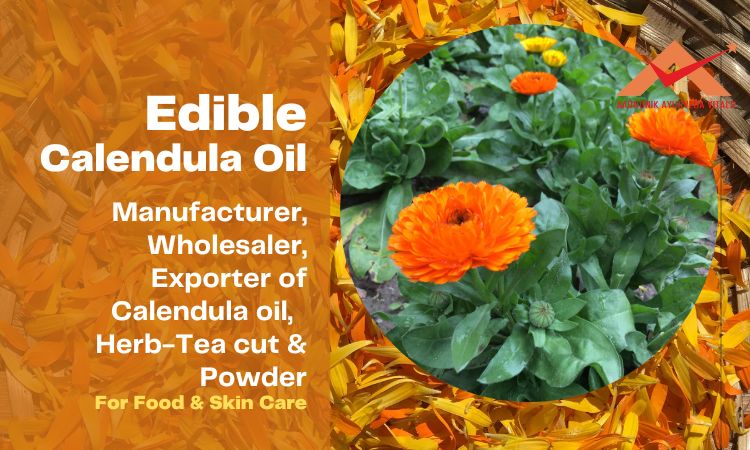
Calendula Oil and Hydrosol Manufacturer in India
Our skin begins to lose its luster as we age, and damage begins to manifest, this may occur at any age now due to rising pollution levels, and everyone desires even-toned, brightened skin. If you want a brighter skin tone but don’t want to experiment with different chemical products, calendula oil and hydrosol for skin brightening & hydrating are for you.
Aadhunik Ayurveda is a reputed organic beauty products manufacturer India, offering skin-friendly calendula-based raw materials.
Calendula, widely known as pot marigold, is prized for its culinary, medicinal, and therapeutic properties. The use of calendula for skin care is on the rise due to its relaxing and anti-inflammatory effects. The benefits of calendula for skin health are numerous. It hydrates the skin and enhances its overall appearance. Aside from that, this powerful plant possesses a slew of skin-friendly qualities.
As a trusted raw ingredient supplier for skincare, we supply calendula oil and hydrosol for face creams, lotions, and healing ointments.
What is Calendula good for?
Calendula has a host of skin-friendly phytochemicals including flavonoids and carotenoids. The flowers are rich in alpha and beta amyrin, lupeol, quercetin, etc,, which renders them excellent antioxidants and anti-inflammatory properties.
This herbal extract can soothe irritated skin, calm inflammation, and promote faster wound healing. If used appropriately, calendula can rejuvenate your skin, making it look softer, younger, and dewy-fresh.
Aadhunik is a renowned herbal extract manufacturer India, producing high-quality calendula for wellness and skincare brands.
Calendula Oil
Calendula oil is derived from the calendula flower and has a variety of health benefits. From UV protection to relieving irritation and dryness, from hydration and nutrition to delaying the symptoms of aging, there’s something for everyone. Calendula oil for skin treatment has been well-known in the cosmetic industry for decades, but nothing surpasses the oil-fashioned homemade recipes, which are both organic and skin-friendly.
Our calendula oil is infused using oils sourced from our in-house facility as a trusted carrier oil manufacturer India.
How Calendula Oil is obtained
Calendula oil is an all-natural, vitamin-rich moisturizer used for various purposes. It’s particularly known for its anti-inflammatory properties and ability to soothe dry, cracked skin. It is extracted from calendula flowers using an infusion method. The color of calendula oil ranges from pale yellow to deep orange. It has a negligible sweet, herbaceous aroma with woody-musty undertones. Calendula does not contain essential oil hence when subject to distillation, it produces only the hydrosol.
Traditionally too, calendula oil was prepared using an infusion method where a carrier oil like sunflower, jojoba oil, coconut or sesame is used to infuse dry, semi-dry or fresh petals.

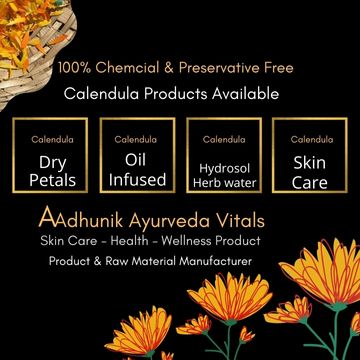
Making of Calendula Essential Oil & Hydrosol at Aadhunik Ayurveda
The making of calendula essential oil & steam distilled calendula hydrosol India at Aadhunik Ayurveda is by using the traditional best clean & healthy technique of herb infusion in oil.
We proudly stand as a certified essential oil manufacturer India, offering safe and clean calendula oil manufacturing under GMP norms.
The technique is 100% environment friendly and the product is the most potent, effective, and healthy for human use. This technique produces edible and highly therapeutic oil.ideal for brands seeking an edible calendula oil supplier India.
Private Label Calendula Skincare and Wellness Products Manufacturer
Aadhunik Ayurveda has a wide range of Calendula skincare and wellness products range includes:
- Private Label Calendula Herb Water
- Private Label Calendula baby balm.
- Private Label Calendula Face Mist
- Private Label Calendula Herb Infused Oil
- Private Label Calendula Face Moisturiser
- Private Label Calendula healing salve
- Private Label Calendula Body Lotion
- Private Label Calendula Body Mist
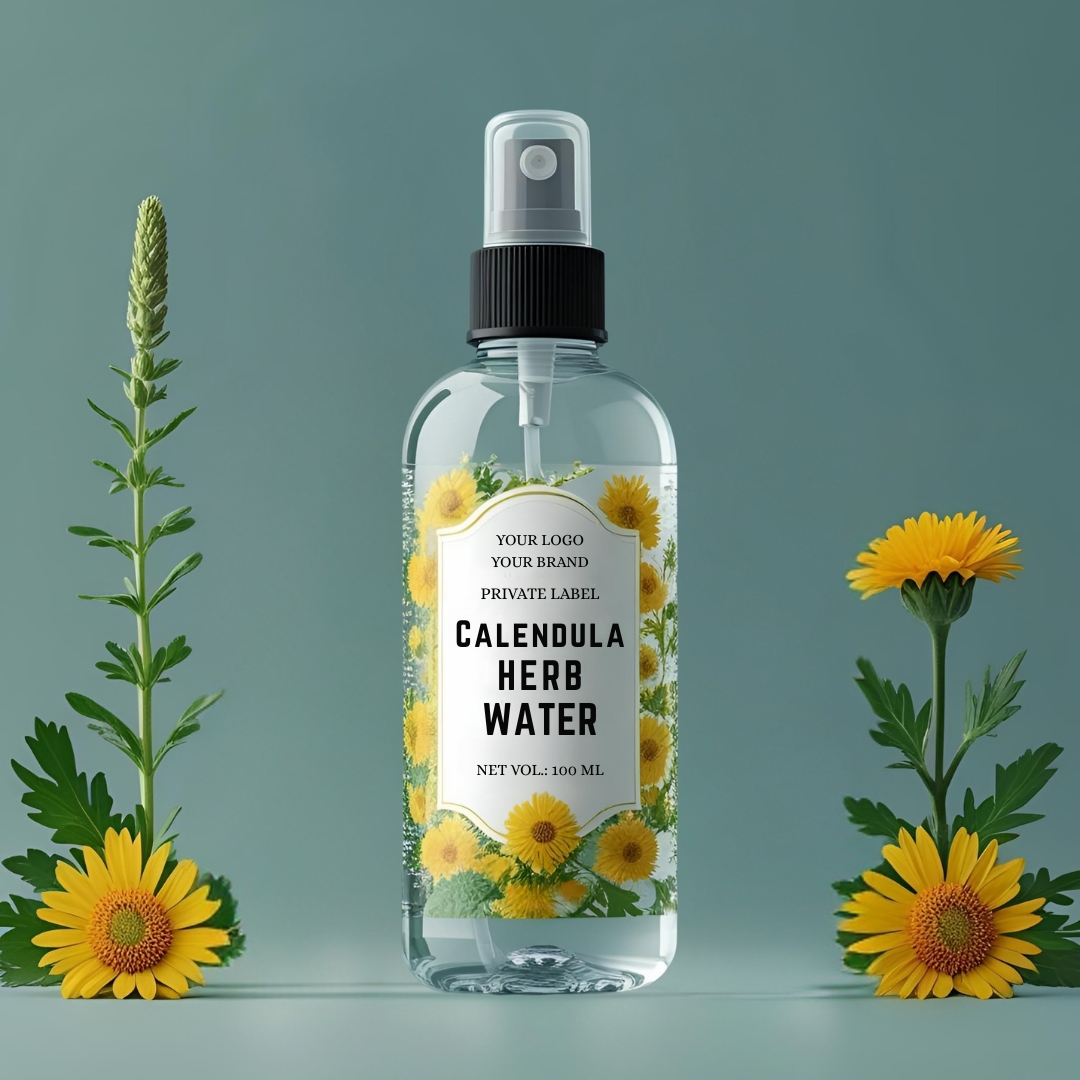
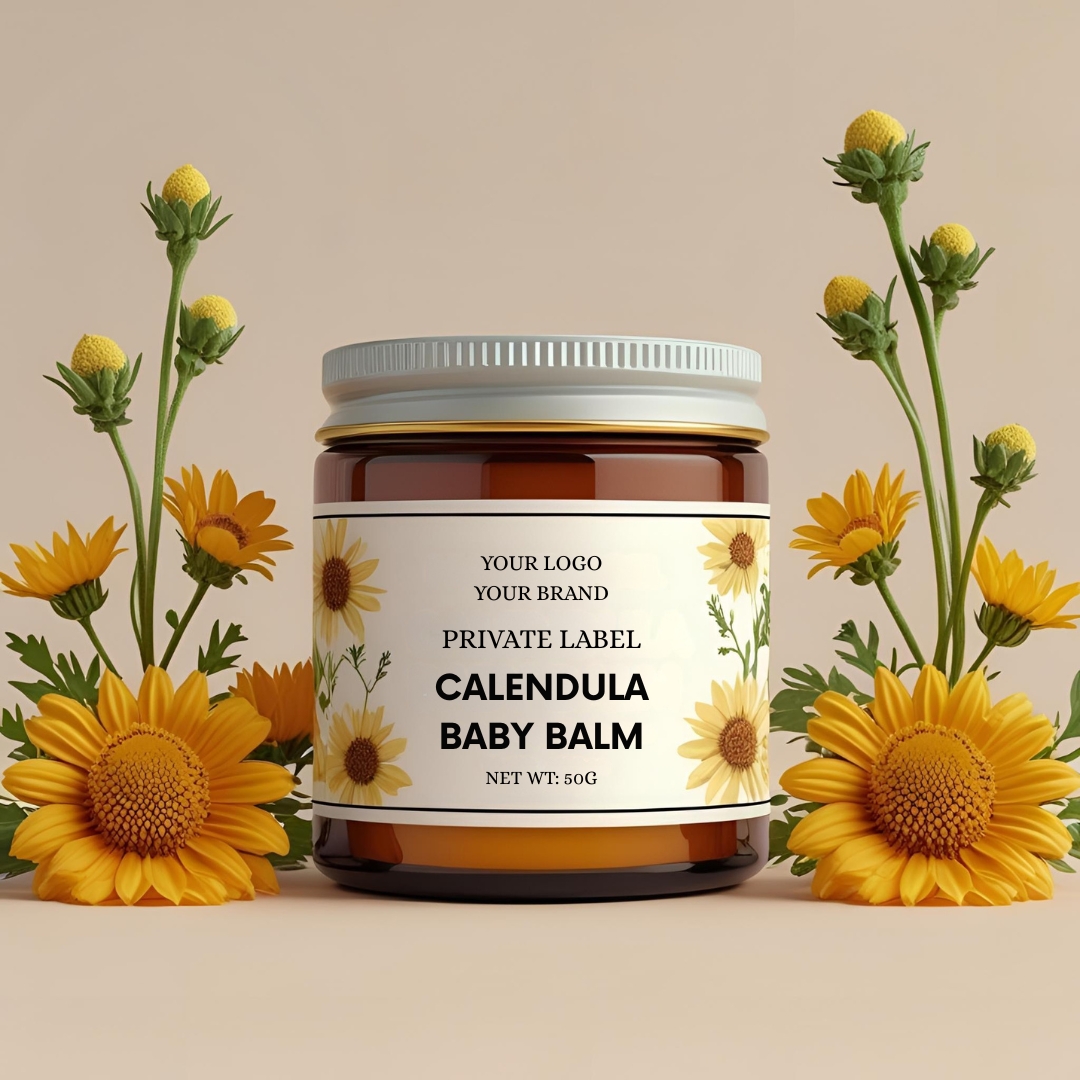

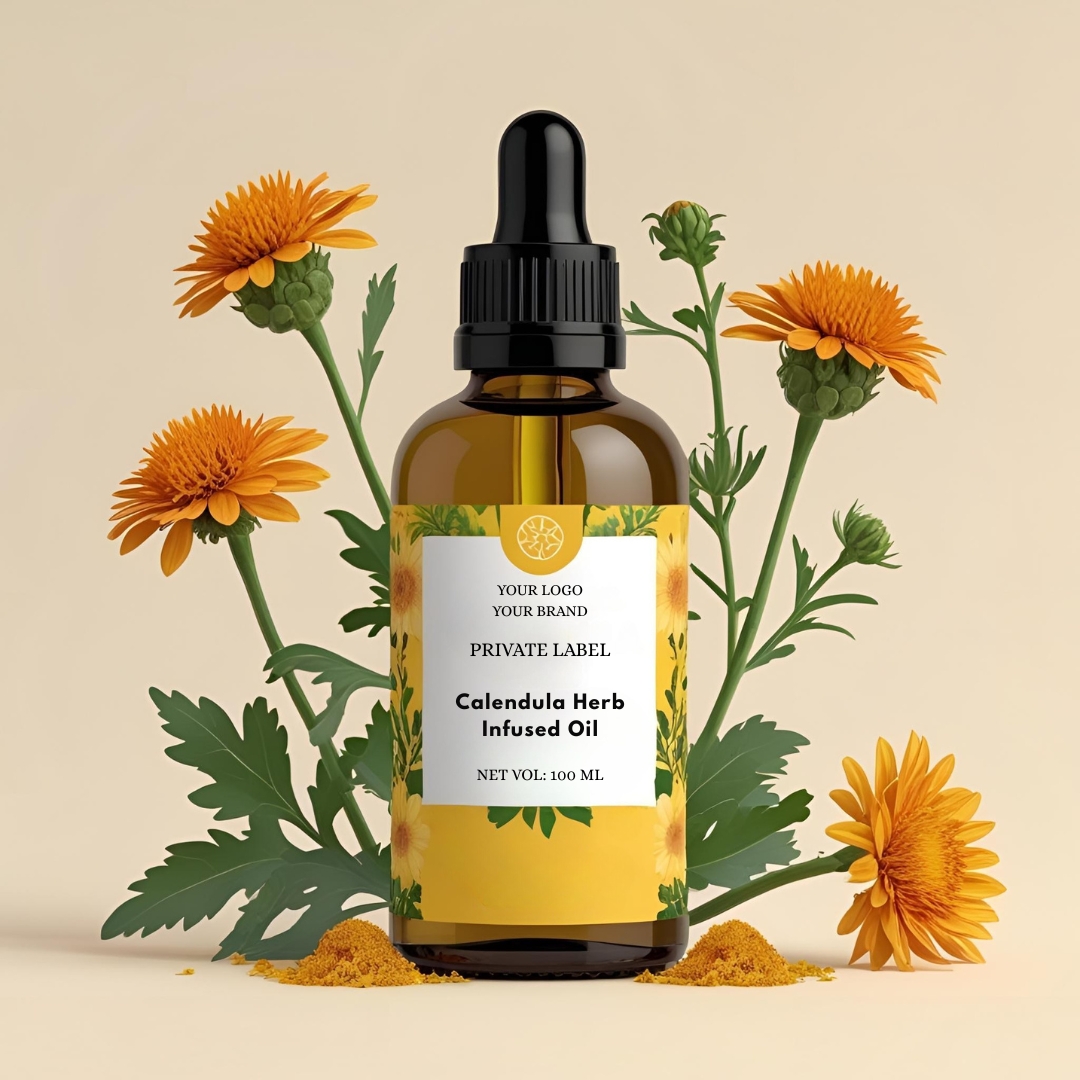


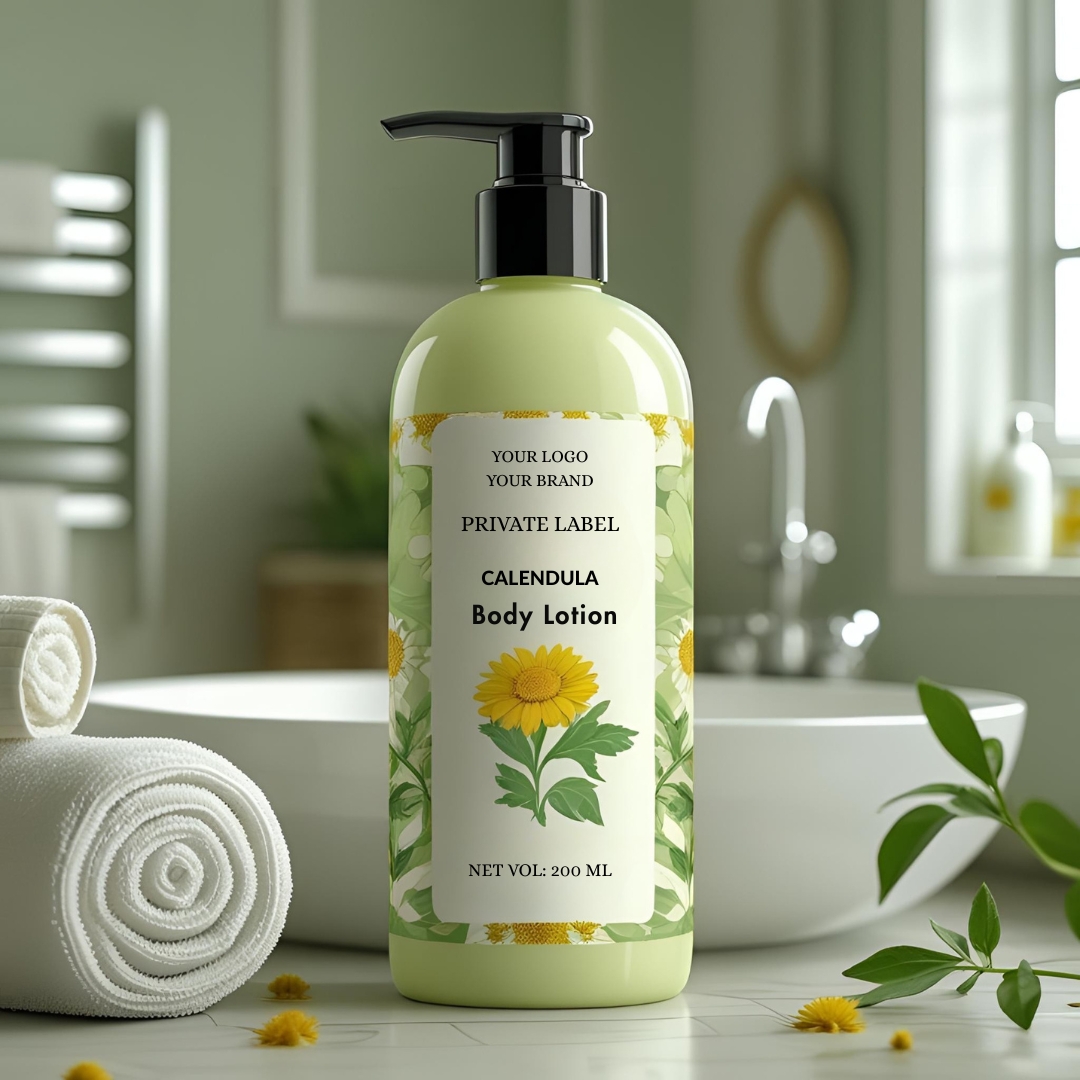

Bulk Manufacturer, Supplier, Wholesaler & Exporter of Calendula Oil & Hydrosol
Aadhunik Ayurveda is one of the best Calendula oil manufacturer in India and Calendula hyrosol manufacturer in India, also serving as a calendula flower oil wholesale India and pure calendula hydrosol exporter to global skincare and personal care brands.
As a bulk cosmetic ingredient manufacturer India, we supply calendula in large volumes for formulation and private label production.
The calendula used in the making of oil & hydrosol is sourced from farmers from different places in Uttarakhand. Calendula is cultivated in winters from October to march.
We assure you that all our products adhere to the highest criteria of safety and quality. We offer natural & organic calendula oil forms (in-house) of oils and hydrosol to our customers. Our products are free from all chemicals, additives, & fillers. They also do not carry any artificial colors, preservatives, and fragrances.
Calendula oil and hydrosol is skin-friendly and safe. You can use it for various purposes including Calendula oil for baby care formulations and Calendula hydrosol for sensitive skin.
We are also recognized as a leading herbal powder supplier India, providing dried calendula for powder-based skincare preparations.
We work with proven methods for activities like processing, packaging, and delivery. Our wide range of edible pure herb oils including hibiscus oil, methi oil, bhringraj oil etc. are available at reasonable rates. We are the leading supplier of pure & edibles infused herb oils, cold pressed oils and essential oils catering to the needs of many skin care and food industry brands across the world.
We ensure the best packaging standards and collaboration with top logistic companies like DHL, Blue dart, Delivery, aramex etc., enable us to provide undamaged and effective finished private labeled products or raw material to our customers.
Get calendula herb products - private label or raw material with ease and with all compliances at low investment only at Aadhunik Ayurveda Vitals – your trusted Private label calendula oil manufacturer and Certified calendula oil and hydrosol exporter.
We are a trusted ayurvedic product manufacturer for export, shipping calendula products globally with all necessary documentation.
Side effects of Calendula
Although calendula is considered safe for most people when taken orally or applied to the skin topically, it may cause the following side effects:
- May cause sleepiness/ drowsiness
- May affect normal hormone function
- Could cause allergic reactions, especially if another plant allergy is present
Precautions
Avoid calendula if you’re allergic to plants in the Asteraceae/compositae family. Always do a patch test when using it for the first time.
COA of Calendula Hydrosol
Physico-chemical and Phytochemical Study & Microbial Analysis of Calendula Hydrosol
Abstract: Calendula officinalis, a member of the Asteraceae family, is an annual plant with yellow to orange blossoms, mostly seen in the Mediterranean region. Also known as pot marigold, it has been grown as a food and medicinal plant since the Middle Ages. As a medicine, it has found applications in the treatment of inflammation and skin wounds. The aim of the present study was to study the physico-chemical and phytochemical screening using the various phyto-chemicals from the blossoms of Calendula officinalis.
Calendula hydrosol is found to contain various secondary metabolites like Triterpenoids, Steroids, Glycosides, Saponins, Alkaloids, Flavonoids, and Tannins.
The phytochemicals produced from the hydrosol of Calendula Officinalis may be used as tools for quality control of drugs in the future, for the healing of a diversity of disease conditions.
Introduction
Calendula officinalis known as Marigold, this annual tree comes from the Asteraceae Family. It is composed of single-orange-yellow flowers that absorb the energy and heat of the sun as it rises in the morning; it is most evident in the Mediterranean region. Plant species are reported to contain a variety of chemicals, including carbohydrates, phenolic compounds, lipids, steroids, tocopherols, terpenoids, quinones, carotenoids which possess different health benefits. The main active ingredients of this plant include saponins, and flavonoids including rutin and hyperoside.

Calendula hydrosol has various therapeutic effects and is used as an antiseptic, stimulant, diaphoretic and antispasmodic. antipyretic agents. The flower petals of the plant have antimicrobial effects on HIV. Calendula plant shows anti-cancer activity in various plant types found in leukemias, fibrosarcomas, melanomas, breast, cervical, pancreas and lungs. It is also used internally for the treatment of gastritis, colitis and haemorrhoids. Antibacterial activity can be found in methanolic extract whereas, antifungal activity can be found in both methanolic and ethanolic extract.
The present work evaluates the aromatic waters/ hydrosol of Calendula obtained as innovative commercial products of a steam distillation process.
The following tables provide information on the most commonly tested physico-chemical and phytochemical test, and Microbiological analysis in Calendula Hydrosol.
| Product Name | Calendula Hydrosol/ Herb Water |
| Botanical Name | Calendula officinalis |
| Manufacturing Process | Steam distillation only |
| Part Used | Blossoms |
| Produce | 100% chemical & preservative free |
| Usage | Cosmetic, Body & Skincare, Health & Wellness, Aromatherapy, Natural perfumery |
| Cultivation | Parts of north India |
Experiment
This analysis is done to analyse the physicochemical, heavy metals, phytochemical and microbial test activity of Calendula Hydrosol.
1.1 Physico-chemical Analysis
Various physico-chemical parameters of Calendula hydrosol were analysed which were important for production of value added products.
Result of physicochemical attributes of analysis in a sample of Clove Hydrosol
| Properties | Specifications | Results |
| Physical Appearance | Transparent liquid, like water | Conforms |
| Colour | Clear colourless to slightly cloudy liquid | Conforms |
| Odour | Refreshing, soothing, sweet, mildly floral aroma | Conforms |
| Solubility | Soluble in water & alcohol insoluble in fixed oils | Conforms |
| pH(25°) | 4.0-7.0 | 4.13 |
| Acid Value | 0.04% | Conforms |
| Refractive Index | 1.300-1.350@20° | 1.342 |
| Specific Gravity 9g/ml) | 0.980-1.2020@25° | 0.9091 |
1.2 Total Presents of Components
| Components | Range % | % |
| Calendula hydrosol | >99.95% | NA |
| Total content of essential oil | <0.5% | NA |
1.3 Heavy Metals Test Result
| Heavy Metal Test | Specification (%) | Result(%) |
| Arsenic (As) | NA | Not detected |
| Lead (pb) | NA | Not detected |
| Mercury (Hg) | NA | Not detected |
| Cadmium (Cd) | NA | Not detected |
| Copper (Cu) | NA | Not detected |
1.4 Result of Phytochemical Analysis of Calendula Hydrosol
The following result were obtained after performing the phytochemical test:
This method involves the selective and successive extraction of the plant phytochemical. The analysis of the presence of the main group of natural constituents present in the plant extract was done using different specific reagents. Chemical tests were done to identify bioactive compounds of pharmacological importance through standard methods. Phytochemicals such as were qualitatively determined.
| S.No. | Phytochemical Tests | Calendula Hydrosol Specification | Results |
| 1. | Saponion | (+ve) | Highly present |
| 2 | Triterpenoids | (+ve) | Highly present |
| 3 | Glycoside | (+/-ve) | Slightly present |
| 4 | Steroids | (-ve) | Not present |
| 5 | Flavonoids | (+ve) | Highly present |
| 6 | Tanin | (+ve) | Highly present |
| 7 | Phenol | (-ve) | Not present |
1.5 Result of Microbial Analysis of Calendula Hydrosol
| Microbial | Specification | Results |
| Aerobic Mesophilic Bacterial Count | <100 CFU/g | Conforms |
| Yeast and Mould | <10 CFU/g | Conforms |
Description
- Appearance- The Calendula hydrosol/floral water is in a liquid form similar to water. That is the reason it is soluble in water.
- Colour- The calendula hydrosol is a clean, colourless to slightly cloudy liquid.
- Odour- The odour of a calendula hydrosol is derived from the blossoms of a calendula plant. The odour of calendula floral water has a refreshing, soothing, sweet, mildly floral aroma However the aroma changes from season to season with variety in its volatile compounds due to various factors like - temperature, rainfall, humidity and soil health etc.
- Solubility- It is soluble in water and alcohol but insoluble in fat/fixed oils.
- pH- A pH of 7 is neutral, above 7 the pH is alkaline and below 7 the pH is acidic.
- Acidity/Acidic- Calendula floral water is acidic in nature as it has a low pH, as opposed to a base, which has a higher pH.
- Specific Gravity- is used to define the weight of a liquid as compared to density at a specific temperature. If the specific gravity for a calendula hydrosol is less than 1, that means the material will flow in the reference substances, and if the water sample is more than 1, that means the material will sink in the reference material.
- Heavy Metals- this test is done to check for irregular levels of toxic or potentially harmful metals. Heavy Metal Limit test is primarily based on the reaction of metallic impurities with hydrogen sulphide or sodium sulphide in an acidic medium to produce metal sulphide which provides brown coloration.
- Microbial Test- is necessary and required by many industries worldwide, where human health is at risk of being adversely affected by disease-causing bacterial & virus, and microbial toxins.
Microbiological analysis of a sample is the use of biological, biochemical, molecular or chemical methods for the identification of microorganisms in a sample.
Observations of Phytochemical Tests for Calendula Hydrosol
1. Saponion
Formation of foam indicates the presence of saponin.
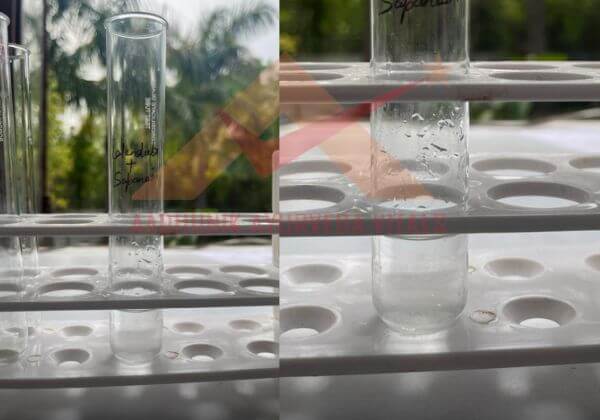
2. Triterpenoids
Formation of reddish, brown colour indicates the presence of triterpenoids.

3. Glycoside
Slightly presence of brown colour ring indicates the presence of glycosides.

4. Steroids
No, formation of yellow, greenish fluorescence on H2SO4 layer.

5. Flavonoids
Formation of red colour indicates the presence of flavonoids.

6. Tannins
Formation of greenish/yellowish colour appearance indicates the presence of tanin.
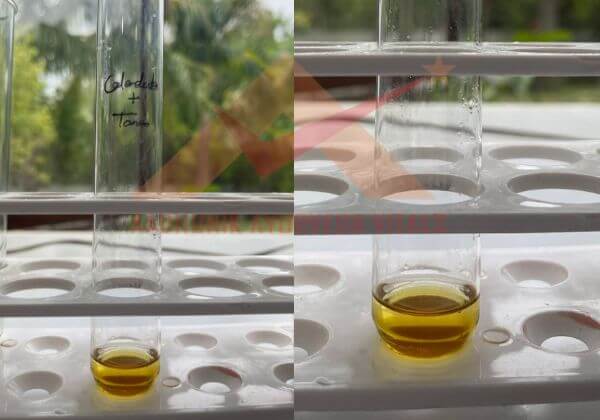
7. Phemol
No, formation of blue or green colour indicates the presence of phenol.

Conclusion
The results of preliminary phytochemical experiments of ethanolic extracts of Calendula hydrosol have shown that hydrosol indicates the presence of phenolic compounds, Tannins, Flavonoids, Triterpenoids, Saponion, Glycosides. It has analgesic, immunomodulatory, anti-inflammatory and neurological behavioural studies.
FAQ
1.Is calendula the same as marigold?
No, calendula is only known as a ‘pot marigold’ and is not the same as a marigold. The two belong to different genera of plants.
2.Is calendula good for dark spots?
Yes, calendula can help fade the appearance of dark spots, acne marks, and hyperpigmentation
3. Is calendula the same as chamomile?
No. though calendula and chamomile belong to the same family Asteraceae, they are different plants.
4. Can I buy Calendula oil and hydrosol in bulk?
Absolutely! As a bulk Calendula oil and hydrosol supplier in India, we offer flexible quantities to meet the needs of both startups and large-scale businesses.
5. Is your Calendula oil certified organic?
Yes, we provide certified organic Calendula oil and hydrosol, manufactured under GMP and ISO standards, ensuring the highest quality and safety for cosmetic and therapeutic use.
6. What makes Aadhunik Ayurveda the best Calendula oil manufacturer in India?
Aadhunik Ayurveda is a trusted Calendula oil and hydrosol manufacturer known for its farm-to-bottle production, steam distillation technique, chemical-free formulations, low MOQs, and strong focus on transparency and quality.
7. Are you a certified essential oil manufacturer India for calendula products?
Yes, Aadhunik Ayurveda is GMP-certified and produces safe, edible calendula oil and hydrosol.
8. Do you supply calendula in powder or dried form?
Yes, we are a herbal powder supplier India offering calendula flower powder for cosmetic and health uses.
9. Can I source calendula oil in bulk for skincare manufacturing?
Absolutely. As a bulk cosmetic ingredient manufacturer India, we offer wholesale calendula oil with private labeling.
10. Do you export calendula-based formulations globally?
Yes, we are an experienced ayurvedic product manufacturer for export, shipping calendula oils and hydrosols worldwide.
11. Do you provide carrier oils for calendula infusion?
Yes, we also operate as a carrier oil manufacturer India, offering oils like jojoba and coconut for infusion.